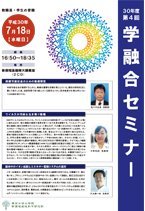AY2018 4th Gakuyugo Seminar
- Date&Time:
- Jul 18, 2018 16:50~18:35
- Venue:
- Large Lecture Room (2C0), New Frontier Science Bldg.

Catalytic research for a sustainable society
Associate Professor Takehiko SasakiCatalysts play an important role in realizing a sustainable society. The current status of our research will be introduced, followed by an overview of our work on immobilized ionic liquid catalysts and computational chemistry.

A clever survival strategy for viruses
Associate Professor Kazumin NakanoBoth DNA and RNA viruses insert only their own blueprints (genome) into the host cell (factory) and replicate themselves using the host cell's machinery and tools. The length of time the viral genome remains in the host cell varies from virus to virus, but the best example is probably the human leukemia virus (HTLV-1). HTLV-1, a retrovirus, has a single-stranded RNA genome that is permanently integrated into the host human genome after reverse transcription of the genomic RNA into double-stranded DNA. Infected T cells are immortalized by early viral activity and are thought to live for decades. The immortalized infected T cells are eventually transferred to the child's body via breast milk and spread to the next generation. Infected T cells that live for decades sometimes accumulate a variety of molecular abnormalities that eventually lead to serious diseases such as adult T-cell leukemia (ATL) and HTLV-1 associated myelopathy (HAM). The main reason for this is that we still do not fully understand how HTLV-1 hijacks the host T cell's intracellular environment and functions to avoid the immune response in vivo and allow infected T cells to survive. In this talk, I will introduce the clever strategy of the virus to manipulate host cells according to its own blueprint, focusing on HTLV-1, and discuss the forefront of the strategy to develop antiviral drugs against it.

Ion Diffusion in Solids and Design of Energy Conversion Systems
Associate Professor Junichiro OtomoIonic conductors are important materials that support power generation and energy storage technologies. In this lecture, ion diffusion in solids such as oxide ions, protons, and lithium will be explained, and a group of materials that are currently attracting attention will be introduced. By linking the conduction properties of ions, electrons, and holes in solids with chemical reactions, it becomes possible to apply them to various energy conversion technologies. The design of these devices and systems will be discussed, including the latest topics in fuel cells, electrosynthesis, and hydrogen production.
*The contents of this page were developed based on a machine translation.

